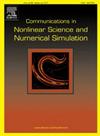Impact of network heterogeneity on neuronal synchronization
IF 3.4
2区 数学
Q1 MATHEMATICS, APPLIED
Communications in Nonlinear Science and Numerical Simulation
Pub Date : 2025-04-03
DOI:10.1016/j.cnsns.2025.108810
引用次数: 0
Abstract
Synchronization dynamics is a phenomenon of great interest in many fields of science. One of the most important fields is neuron dynamics, as synchronization in certain regions of the brain is related to some of the most common mental illnesses. To study the impact of the network heterogeneity in the neuronal synchronization, we analyze a small-world network of non-identical Chialvo neurons that are electrically coupled. We introduce a mismatch in one of the model parameters to introduce the heterogeneity of the network. Our study examines the effects of this parameter mismatch, the noise intensity in the stochastic model, and the coupling strength between neurons on synchronization and firing frequency. We have identified critical values of noise intensity, parameter mismatch, and rewiring probability that facilitate effective synchronization within the network. Furthermore, we observe that the balance between excitatory and inhibitory connections plays a crucial role in achieving global synchronization. Our findings offer insights into the mechanisms driving synchronization dynamics in complex neuron networks.
网络异质性对神经元同步的影响
同步动力学是许多科学领域非常感兴趣的现象。其中最重要的一个领域是神经元动力学,因为大脑某些区域的同步与一些最常见的精神疾病有关。为了研究网络异质性对神经元同步的影响,我们分析了一个由电偶联的非相同Chialvo神经元组成的小世界网络。我们在其中一个模型参数中引入一个不匹配来引入网络的异质性。我们的研究考察了参数失配、随机模型中的噪声强度以及神经元之间的耦合强度对同步和放电频率的影响。我们已经确定了噪声强度、参数不匹配和重新布线概率的临界值,这些临界值促进了网络内的有效同步。此外,我们观察到兴奋性和抑制性连接之间的平衡在实现全局同步中起着至关重要的作用。我们的发现为复杂神经元网络中驱动同步动力学的机制提供了见解。
本文章由计算机程序翻译,如有差异,请以英文原文为准。
求助全文
约1分钟内获得全文
求助全文
来源期刊

Communications in Nonlinear Science and Numerical Simulation
MATHEMATICS, APPLIED-MATHEMATICS, INTERDISCIPLINARY APPLICATIONS
CiteScore
6.80
自引率
7.70%
发文量
378
审稿时长
78 days
期刊介绍:
The journal publishes original research findings on experimental observation, mathematical modeling, theoretical analysis and numerical simulation, for more accurate description, better prediction or novel application, of nonlinear phenomena in science and engineering. It offers a venue for researchers to make rapid exchange of ideas and techniques in nonlinear science and complexity.
The submission of manuscripts with cross-disciplinary approaches in nonlinear science and complexity is particularly encouraged.
Topics of interest:
Nonlinear differential or delay equations, Lie group analysis and asymptotic methods, Discontinuous systems, Fractals, Fractional calculus and dynamics, Nonlinear effects in quantum mechanics, Nonlinear stochastic processes, Experimental nonlinear science, Time-series and signal analysis, Computational methods and simulations in nonlinear science and engineering, Control of dynamical systems, Synchronization, Lyapunov analysis, High-dimensional chaos and turbulence, Chaos in Hamiltonian systems, Integrable systems and solitons, Collective behavior in many-body systems, Biological physics and networks, Nonlinear mechanical systems, Complex systems and complexity.
No length limitation for contributions is set, but only concisely written manuscripts are published. Brief papers are published on the basis of Rapid Communications. Discussions of previously published papers are welcome.
 求助内容:
求助内容: 应助结果提醒方式:
应助结果提醒方式:


